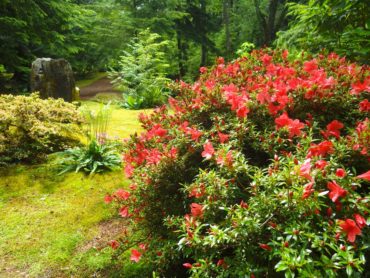 Rhododendrons are beginning to bloom their hearts out. They thrive in this region but are not without their share of hungry pests and sneaky diseases. A little understanding of common rhododendron problems is useful for maintaining healthy specimens.
Rhododendrons are beginning to bloom their hearts out. They thrive in this region but are not without their share of hungry pests and sneaky diseases. A little understanding of common rhododendron problems is useful for maintaining healthy specimens.
Trying to identify plant problems can be tricky. Often, different issues cause similar symptoms, or multiple problems may happen to the same plant at the same time. A comprehensive guide to all rhododendron problems is too extensive for this article, but this can serve as a starting place for the budding plant detective.
Common rhododendron problems are listed below according to the symptom observed.
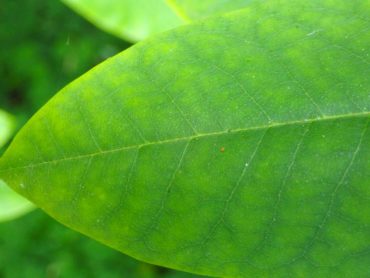
Yellow Leaves
Yellowing leaves (chlorosis) on a rhododendron are not only a common symptom, almost every problem seems to result in some yellowing. Fortunately, the pattern of yellowing can be a clue to the issue at hand.
Interveinal yellowing: Are the leaf veins green but the in-between space yellow? This usually indicates the rhododendron is not getting enough iron, although it may less commonly be caused by deficiencies of certain other nutrients.
In the case of iron deficiency, the problem is rarely insufficient iron in the soil. Usually, the pH is too high.
The pH is a measure of acidity or alkalinity, ranging from 1 to 14. A pH of 7 is neutral. Soils with a pH above 7 is alkaline. Below pH 7 is considered acidic. Rhododendrons prefer acidic soils with a pH between 4.5 and 6.
In soils, iron becomes less available to plants as the pH rises. Rhododendrons are sensitive to low iron due to high pH and will exhibit interveinal yellowing, especially on younger leaves as a result of lacking iron uptake.
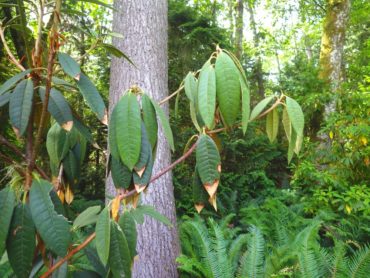
Rhododendrons growing in excessively wet soils or plants that are just watered too much may also exhibit interveinal yellowing. Too much water for long periods results in reduced oxygen in the root zone, effectively asphyxiating the roots. Plants and their roots need oxygen.
Among other consequences, low oxygen inhibits iron uptake and the plant produces symptoms of iron deficiency (interveinal chlorosis).
Overall yellowing: Is the yellowing more or less even over the surface of the leaf? Over the entire plant, either all leaves will be yellowing this way or just the older leaves, with younger leaves being more green. Most likely this is a nitrogen deficiency and can be corrected by adding a slow-release nitrogen fertilizer to the soil around the rhododendron.
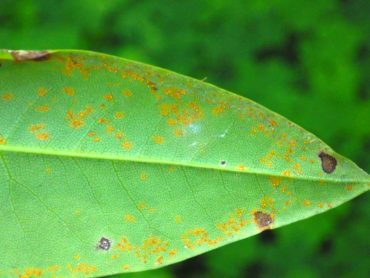
Central yellowing: Rhododendron leaves that are more yellow in the center of the leaf and greener around the edges may be showing signs of sunburn. In severe cases of sunburn, the yellow areas may even have brown or whitish spots, and even the edges may turn yellow. While many rhododendrons can tolerate some sun, long periods of full sun can cause sunburn.
Shade-loving rhododendrons can burn when planted in full sun but even sun-tolerant species may burn if subjected to drought stress. Insufficient soil moisture in hot weather aggravates sunburn in plants, causing them to burn more than they might otherwise. Keep sun-grown rhododendrons adequately watered!
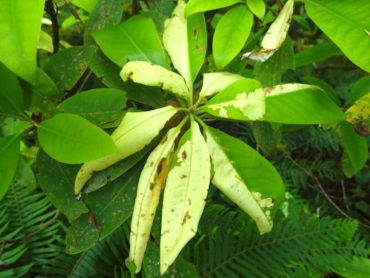
Chewed Leaves
Small chewed notches: Root weevil adults will chew notches or occasionally larger “pathways” in a leaf starting from the edge. The snout-nosed adults hide on the ground during the day and crawl up the trunks at night to feed on the leaves.
They usually appear in May, and the best chemical-free way to control them is to go out at night with a flashlight and pick the weevils off by hand. Sticky bands of Tanglefoot or similar products can work if placed appropriately but they have also been known to catch small birds.
Larger, vaguely U-shaped notches: Various cutworms or other caterpillars sometimes feed on rhododendrons. Again, you may have to pick this pest off by hand, although often they have turned into moths or butterflies by the time the damage is noticed.
Entire or almost entire leaves bitten off: On very, very rare occasion, deer will eat rhododendron leaves despite the fact that rhododendrons are considered highly deer resistant. While that’s true, some deer may resort to rhododendrons as food in the winter.
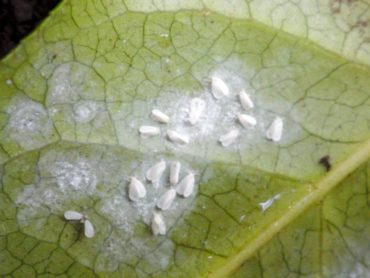
Bugs!
Tiny, white “flies”: Appearing like little flies but actually related to aphids, white flies are common pests on rhododendrons. They tend to congregate on the undersides of leaves.
In colder weather, they are inactive but in warmer temperatures, they tend to fly around their host plant when disturbed. Fortunately, they rarely do noticeable damage on outdoor plants like rhododendrons. They are a greater concern in greenhouses or on houseplants.
Aphids: Tiny, pear-shaped insects, aphids are so common that even most nongardeners recognize them. They damage rhododendrons by sucking out plant juices and in high enough numbers, they can damage new shoots and cause leaf deformities.
They are best controlled by squishing with fingers while still on the stems. More squeamish people may wish to invest in rubber gloves.
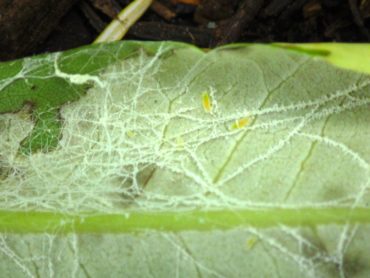
Wilting Leaves
Downward-drooping leaves indicate that the leaves may not have enough internal water, but the cause is not always overly dry soil; setting a sprinkler on your wilty rhododendron may not fix the problem unless the soil is actually dry.
Cold response: Did the rhododendron leaves only wilt when it got very cold outside in the winter? In cold weather, rhododendron leaves may wilt and curl up from the edges, making them look like little cigars. Do not worry if this happens. The rhododendron will recover once warmer periods return.
The exact purpose of this cold response is still not known for sure but appears to probably prevent damage from repeated freeze/thaw cycles and protect the cellular photosynthetic machinery of rhododendron leaves.
Root rot: Root-rotting fungi can invade and kill roots. Affected rhododendrons will wilt even in wet soil because dead roots cannot absorb water for the plant.
Usually, these disease organisms take hold in excessively wet soil conditions. Most soils have root rotters present at least in low numbers, waiting for a plant to be weakened from too much water, other diseases or some other condition. Once that happens, the root-rot fungus can take strong hold of a plant and sicken or even kill it.
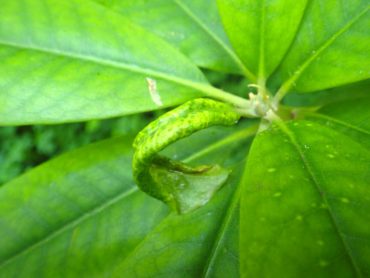
While fungicides can help, the root rotter will return to the rhododendron if conditions that promoted its success are not dealt with. Excessive water is the problem most of the time, whether from poor soil drainage or application of too much water via sprinklers. It might be too late for the wilty rhododendron, but correcting the water problem may allow the next plant in that spot to fare better.
Only one or more branches are wilting (or are dead): If only a portion of the plant is wilting, a root rot is unlikely. Check first for broken branches, as this is the most common cause of a single wilting limb.
If there is no break, check for missing bark, indicating that some animal, usually a vole or a squirrel, has chewed off bark. Voles tend to feed on bark around the base of the plant, while squirrels may climb up into the branches.
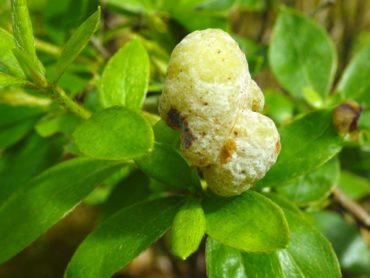
Bark-feeding is often a winter activity and may go unnoticed until spring, when temperatures rise and the leaves suddenly need more water than they can take up through the branch with some of its bark missing.
Lacking broken branches or chewed bark, an internal fungus may be the culprit. On rhododendrons, this is most often a fungus called Botryosphaeria (Botryosphaeria dieback or “Botryo” for those in the know).
Cutting into the stem, especially lower down on the stem closer to healthier branches, may reveal brown “wedges” in cross section. The darker brown areas are portions of wood that have died because the fungus has plugged up the water-transport system, preventing the branch beyond the plug from getting enough water.
Unfortunately, this disease is hard to deal with. Prevention is the best method: Water your plants adequately because this disease is an opportunist of water-stressed rhododendrons.
Diseased branches can be pruned off by cutting back to healthy wood that lacks the brown wedges. And always sanitize your pruning tools with 70 percent alcohol between cuts to prevent spreading the disease.
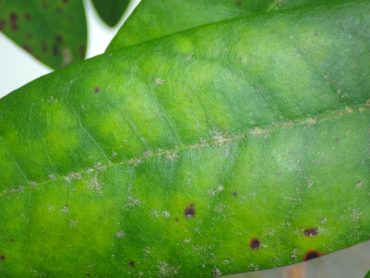
Dead Leaves
Dead plants tell no tales. Once a plant has died, you might be able to glean clues to its demise by examining its corpse and environment, but it is much easier to determine the problem before the plant has completely died. After death, the culprits may disappear and any fungus found may simply be feeding on the dead plant and not be the cause of its death.
Wet soil or bark damage at the trunk may be clues of potential killers. Other symptoms like chewed leaves are not helpful — leaf-chewing insects rarely actually kill their hosts. Wood-boring beetles in larger trunks also tend to be secondary problems and may not have been the primary cause of death.
Other Symptoms
Brown leaf tips: Usually this indicates the rhododendron has not been able to absorb enough water from the soil. Normally it is from inadequate watering but sometimes a low-level root rot may be to blame if the soil is continually moist in warmer temperatures. A fungus may also be the cause.
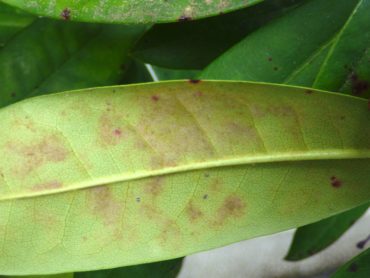
Leaf spots: Brown spots on the leaf are often caused by a fungal infection. There are many species of fungi that may attack rhododendrons. These spots are usually unsightly but not a major problem.
Nonchemical-control strategies involve removing potentially infected leaf litter, pruning to improve air circulation and avoiding overhead irrigation that wets the leaves.
White leaves: New leaves that emerge white (or rarely peach or light pink) are infected with a fungus called Exobasidium. White leaves may show a powdery webbing underneath. The webbing is not from insects or spiders but rather the fungus itself.
Infected shoots also tend to produce more frequent and more vertical branching than on uninfected shoots.
While infected plants may last indefinitely or only die after many years, reasonable control can be achieved by pruning out infected shoots as they appear. On azaleas, this same fungus produces distorted leaf galls rather than white leaves.
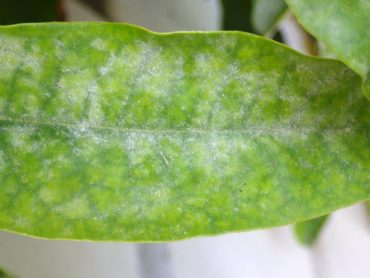
White power: A white, powdery coating on the upper leaf surface is a fungus called powdery mildew. Some low-toxicity fungicides work very well against powdery mildews. Sulfur or some formulations of insecticidal soaps work very well. Whatever you use, always follow the label instructions.
Yellowish blotches: Yellow spots on the upper leaf surface, almost always associated with a purplish blotching on the underside, are another manifestation of powdery mildew. Some rhododendrons, especially those with larger, evergreen leaves, do not develop the white powder when infected with powdery mildew.
This form of powdery mildew is not as easily controlled by the lower-toxicity fungicides. Luckily, this version is not as unsightly and is unlikely to cause significant harm to the plant.
Orange spots: Tiny, orange dots underneath the leaf that look powdery, especially with a magnifying glass, are usually caused by rust fungi. Most of the time, they are not a significant health problem for the rhododendron.
In cases where the rust fungus is causing a decline (usually yellowing or stunting), control with low-toxicity fungicides can be difficult because of the complex lifecycle of the rust fungi.
It is best to identify the rust species involved by bringing it to a Master Gardener clinic. From there, the sample may need to be forwarded to the Washington State University plant-diagnostic laboratory.




























Comments